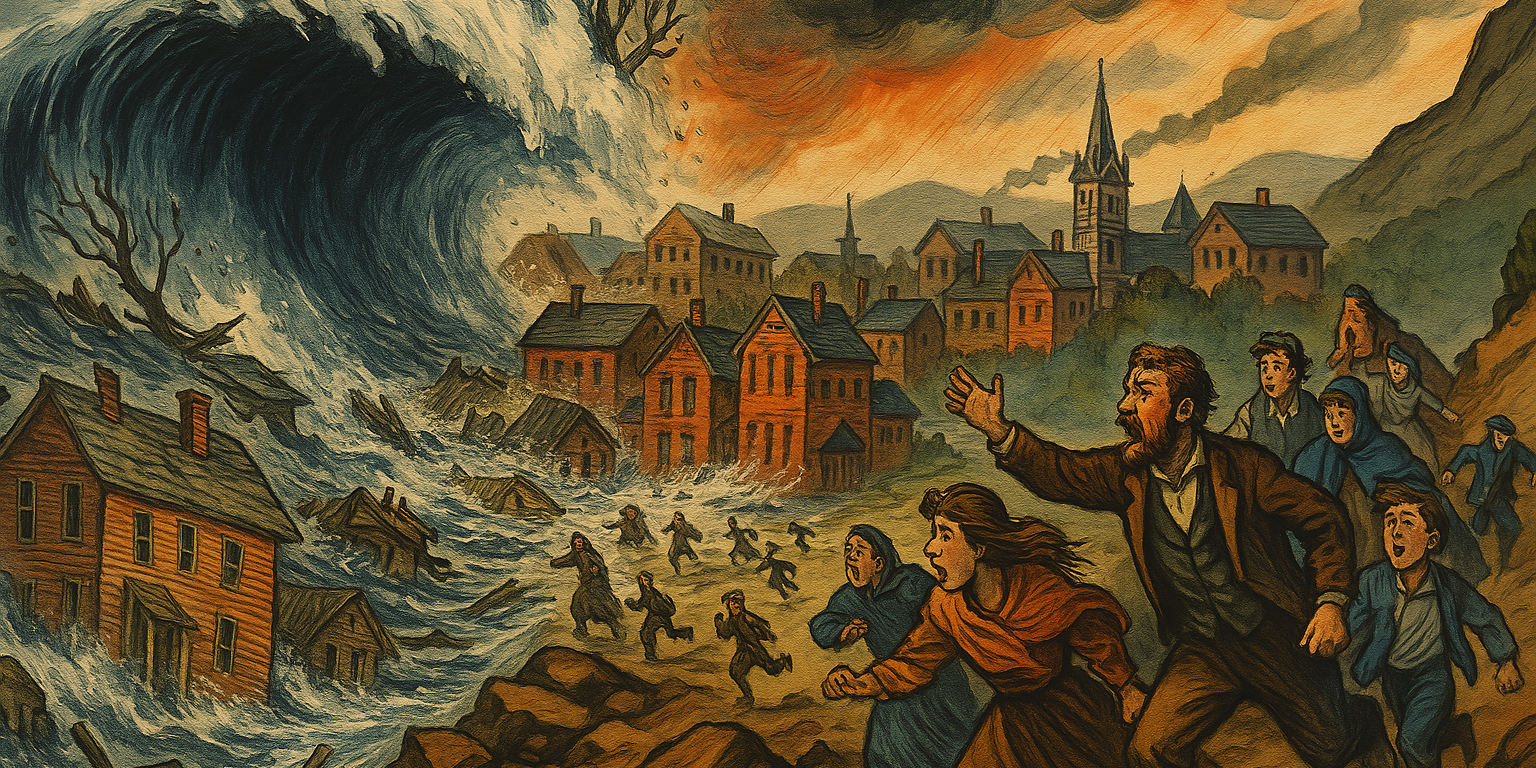On May 31, 1889, a wall of water surged down the Conemaugh Valley in Pennsylvania, wiping entire communities off the map in what remains one of the deadliest disasters in American history. The Johnstown Flood, as it came to be known, was more than just a tragedy—it was a watershed moment that revealed the dangers of unchecked industrial power, the shortcomings of infrastructure, and the resilience of a devastated population. Though Johnstown lies 60 miles east of Pittsburgh, the city’s role in the flood and its aftermath links this story directly to the Steel City’s own legacy.
The Setting: An Industrial Boomtown in a Narrow Valley
In the late 19th century, Johnstown was a thriving steel town much like Pittsburgh. Nestled in a narrow valley along the Conemaugh River, it was home to roughly 30,000 residents—many of them recent immigrants drawn to the promise of work in the city’s booming mills and factories. Like Pittsburgh’s Strip District, Johnstown was packed with workers, rail lines, and the energy of rapid expansion. But the city’s location—low-lying and hemmed in by mountains—made it particularly vulnerable to flooding.
At the top of the valley, the South Fork Dam loomed ominously. Originally constructed in the 1850s as part of a canal system, it was later purchased by the South Fork Fishing and Hunting Club—an exclusive retreat for Pittsburgh’s industrial elite, including steel magnates like Henry Clay Frick and Andrew Carnegie. The dam’s primary purpose had become recreational: holding back Lake Conemaugh, the artificial reservoir used by wealthy club members for boating and fishing.
The club’s membership reads like a who’s who of Pittsburgh industry. Many of its members had a hand in shaping Pittsburgh’s rise as an industrial powerhouse, as outlined in our feature on Steel City’s steel empire. But while they helped build fortunes downstream, they also helped create the conditions for disaster upstream.
Warnings Ignored: A Dam in Disrepair
From the moment the South Fork Fishing and Hunting Club acquired the dam in 1879, concerns about its stability were raised. The original cast iron drainage pipes had been removed, making it impossible to release water in a controlled way. The dam was lowered to accommodate a road, and screens were added to prevent fish from escaping—but these screens clogged easily, exacerbating overflow risks.
Engineers and observers repeatedly warned the dam was unstable. Residents in Johnstown had grown used to false alarms, but May 1889 brought an ominous combination of events: a powerful storm dumped record-breaking rainfall on the region, already soaked from weeks of wet weather. By the morning of May 31, Lake Conemaugh was swelling to dangerous levels.
The Collapse: A Roar Heard Down the Valley
At around 3:10 p.m., the dam gave way with a thunderous crack. An estimated 20 million tons of water—roughly the volume of Lake Erie passing through a two-mile funnel—exploded down the valley at speeds exceeding 40 miles per hour. The force uprooted trees, derailed trains, and hurled entire buildings like matchsticks. Survivors described the sound as a “hundred trains crashing together.”
The torrent reached Johnstown about an hour later. The city’s residents had little warning. Entire neighborhoods were crushed in seconds. People were swept away while still in their homes, at their workplaces, or on the streets. Debris from bridges and homes turned the wave into a battering ram. Gas lines ruptured, igniting fires even as the floodwaters rushed through.
The Toll: A Landscape Erased
When the floodwaters finally receded, the devastation was staggering. Over 2,200 people were dead. More than 750 bodies were never identified. One-third of the city’s homes were gone. In some areas, the debris pile stood 70 feet high. The scale of destruction rivaled that of Pittsburgh’s Great Fire of 1845, but this time, the tragedy unfolded across a valley rather than a city block.
Mass graves were dug. Relief efforts arrived within days, including the first major humanitarian mission by the newly formed American Red Cross under Clara Barton. Pittsburgh newspapers carried daily updates, and donations poured in from across the nation. While Pittsburgh’s elite faced intense scrutiny for their role in the dam’s failure, no one was ever held legally accountable.
Pittsburgh’s Role in the Fallout
Pittsburgh served as the logistical and emotional hub of the response. Trains from the city brought supplies and volunteers. Many of the South Fork Fishing and Hunting Club’s members, including Henry Clay Frick, offered financial support, but few offered public apologies. The club quietly disbanded, its papers destroyed—leaving generations to debate whether the flood was a natural disaster or a man-made atrocity.
Johnstown’s pain was Pittsburgh’s shame. And yet, the event became part of a larger story about industrial America’s growing pains. The nation’s appetite for expansion had come at a terrible cost.
Legacy: Memory, Resilience, and Reform
In the years following the flood, Johnstown rebuilt—again and again, enduring further floods in 1936 and 1977. But none matched the scale or symbolic weight of the 1889 disaster. The catastrophe triggered new conversations about engineering accountability, infrastructure safety, and environmental planning—issues Pittsburgh would also grapple with as it restructured its own riverbanks and railroads.
The Johnstown Flood Museum, housed in a historic library building downtown, preserves the memory today. The National Park Service also maintains the South Fork Dam site as part of the Johnstown Flood National Memorial.
For Pittsburghers, the legacy of the flood is interwoven with the story of their own city’s growth, ambition, and reckoning. Much like the Haunted Allegheny Cemetery, the flood site remains a place where stories linger long after the dust has settled.








